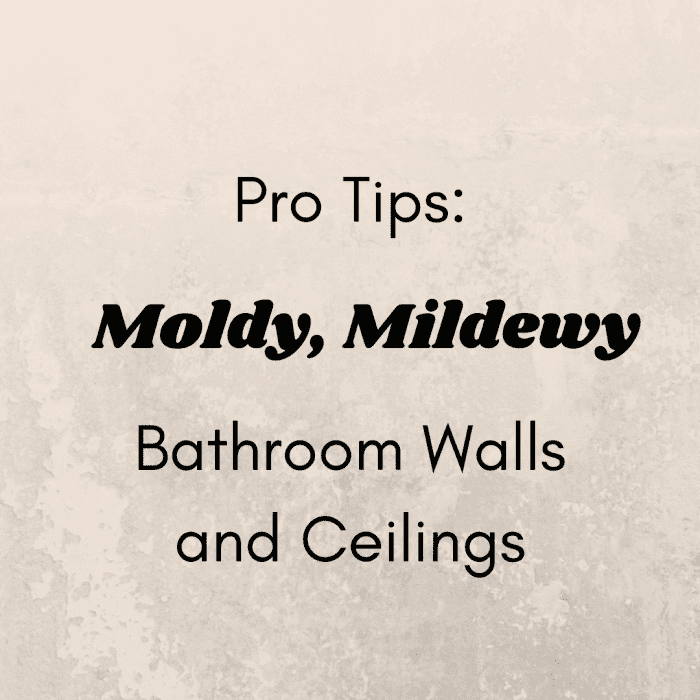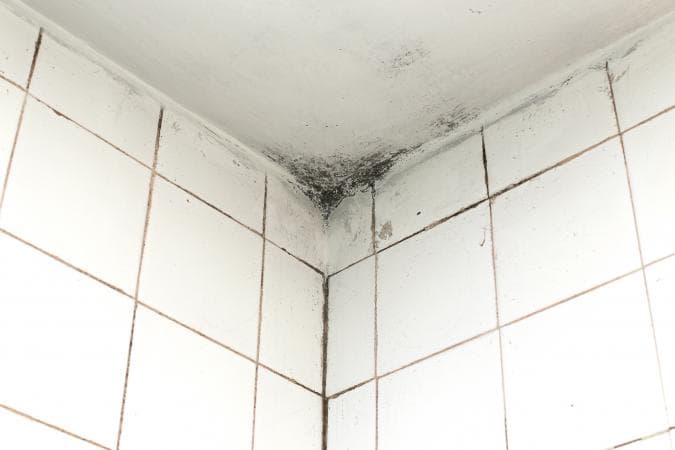Insulation For Bathroom Ceiling
Insulation For Bathroom Ceiling
Matt is a professional painter and freelance writer, sharing his knowledge, house-painting tips, and product reviews.

Don't paint over your moldy, mildewed walls without reading my pro tips.
Can You Paint Over Mold In a Bathroom?
Mold thrives on damp surfaces in poorly ventilated bathrooms that are dark and humid. The hideous fungus becomes a real problem when it's ignored and allowed to spread everywhere, ruining tile grout and drywall. This presents a messy challenge when it comes time for painting.
I painted a moldy bathroom once for a customer who would take abnormally long showers without a proper exhaust fan. The bathroom was constantly humid and poorly ventilated, a perfect breeding ground for mold and mildew.
The bathroom walls, ceiling, and even the air ducts were covered in mold. Needless to say, the drywall underwent a deep cleaning before painting. The customer installed an additional exhaust fan to help remove the excessive moisture.
Painting Over Mold
You can paint over mold in a bathroom, but the problem will return without killing the roots of the fungus first, using the right cleaner. Regular interior paint won't kill mold, and in some cases, water-based paint can actually become a food source for the fungus.
Don't rely solely on mold-killing primer, or paint, without first using a good cleaner to neutralize the surface. Yes, those products can actually kill mold, but only on smooth, glossy drywall, not chalky, porous drywall where the paint's too thick to reach deep below the surface. Why go through the trouble of painting your moldy bathroom without cleaning the surface first?
For repeated mold growth on your bathroom walls and ceiling, pinpointing the cause of the problem is key, whether it's from a weak exhaust fan, or from damp and dirty towels left in there for too long. Frequent cleaning is also one of the best preventative measures you can take to prevent mold growth.

Step 1: Scrub Away Mold
The first household cleaner most people reach for is Clorox bleach, but on porous drywall, the chlorine in bleach doesn't always penetrate deep into drywall to kill the roots of the fungus to permanently stop the growth.
The water in diluted bleach can also end up feeding the mold instead of stopping it for good. Scrubbing walls and ceilings with bleach creates a toxic situation too, without good ventilation and a respirator.
Best Cleaners for Bathroom Mold
- Vinegar
- Baking soda
- Borax
- Hydrogen peroxide
The best natural cleaner I've used to kill bathroom mold for painting purposes is straight vinegar, no water added. Yes, vinegar stinks really bad, but it's non-toxic, and the acidity of vinegar is effective for killing mold on porous drywall. Never mix vinegar with bleach. Doing so produces poisonous gas.
Cover your vanity and bathroom floor with plastic and drop cloths. Pour white distilled vinegar into a spray bottle, or a pump sprayer. Spray undiluted vinegar onto the mold and let it penetrate the surface for a couple hours.
After allowing the vinegar to burn into the mold, scrub the drywall with a stiff bristle brush until all of the mold, or mildew, has washed off. Be sure to wear a respirator, or at the very least, a dust mask, to prevent inhalation of mold spores during cleaning. Allow the bathroom to totally dry out with the windows open before priming and painting.
Read More From Dengarden
Step 2: Apply Primer
After you've killed the mold in your bathroom, it's time to prime and seal over the leftover stains before painting. Don't paint right over them.
Painting over mold stains on drywall, without priming them first, is more likely to allow the ugly dark spots to show through your paint. Without a good primer/sealer, multiple coats of paint would be needed to fully cover the hideous stains.
Your choice of primer here is important too because certain products can actually promote future mold growth, or cause failure of the paint finish. For example, Cover Stain primer, an oil-based product, is an awesome primer/sealer for tough stains, but oil-based coatings can actually feed problematic bathroom mold and mildew.
Another example is BIN shellac primer. BIN is a great primer sealer, but it will crack and peel in a bathroom with high humidity. A mold-resistant, water-based primer, is the best option for priming over bathroom mold and mildew.
The only time I would recommend using oil-based primer, like Zinsser Cover Stain, is for only spot priming water and hairspray stains on drywall, but don't use oil primer across your moldy walls.
Best Primers to Seal Mold
- Zinsser Mold Killing Primer
- Zinsser Bulls Eye 123 (Mold and Mildew Resistant)
The Zinsser/Rustoleum brand has always been my go-to when it comes to specialized interior and exterior primer. Their products have been around forever and work great.
The Zinsser Mold Killing primer is a protective coating that works well for preventing bathroom mold in the future, but as I explained earlier in this article, I would be hesitant to use this product alone to kill the mold.
The product itself even states that it's best used on non-porous surfaces. Unless your bathroom drywall is currently coated with a smooth semi-gloss paint, it's probably more porous. Your best insurance policy to prevent a reoccurring problem is to use a cleaner first, but either of the two recommended products is good for sealing over the stains and preventing future growth.
Step 3: Apply Paint
Now that you've applied the pimer to seal any leftover stains, it's finally time to paint.
Best Paint for Bathroom Mold and Mildew
- Benjamin Moore Aura Bath and Spa Paint
- Benjamin Moore Regular Aura Interior Semi-gloss
- Sherwin Williams Duration Home Interior Satin, or Semi-gloss
- Zinsser Perma-White Paint
All of the recommended products above are effective at preventing mold and mildew growth. These paints are formulated for that specific purpose. You can certainly buy an anti-fungicidal additive and mix it with paint you already have, but improper mixing can cause problems with the paint.
I would definitely choose a semi-gloss paint, or at least satin, when painting your bathroom walls, especially the walls surrounding the shower. The shinier the paint, the more it's going to resist water instead of absorbing it. Apply one coat of primer and two coats of paint.
This content is accurate and true to the best of the author's knowledge and is not meant to substitute for formal and individualized advice from a qualified professional.
© 2020 Matt G.
Insulation For Bathroom Ceiling
Source: https://dengarden.com/home-improvement/Tips-for-Painting-Moldy-Bathroom-Walls-and-Ceilings


Tidak ada komentar:
Tulis komentar